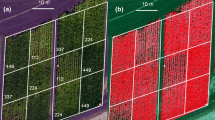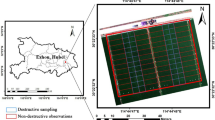Abstract
Examination of seed germination rate is of great importance for growers early in the season to determine the necessity for replanting their fields. The objective of this study was to explore the potential of using unmanned aircraft system (UAS)-based visible-band images to monitor and quantify the cotton germination process. A light-weight UAS platform was used, which carried a consumer-grade red, green, and blue camera stabilized by a built-in gimbal system. In order to obtain ultrahigh image resolution during the germination stage, the UAS platform was flown at an altitude of approximately 15–20 m above ground. By applying the structure-from-motion (SfM) algorithm, the images were rectified and orthographically mosaicked with a ground sampling distance of approximately 6–9 mm/pixel. A novel solution was then developed for calculating the average plant size and the number of germinated cotton plants according to the leaf polygons extracted from the orthomosaic images. By using the estimated number of germinated cotton plants, the plant density and the cumulative germination rate can also be estimated in a straightforward manner using field-specific parameters. An assessment of the proposed solution was conducted by comparing the estimated number of the germinated cotton plants against ground observation data collected from six cotton row segments. The results demonstrated that the average estimation accuracy achieved 88.6% in terms of identifying the number of the germinated cotton plants. The accuracy may be further improved if images with near infrared band are employed.






Similar content being viewed by others
References
AFBF. (2015). Fact sheet: quantifying the benefits of drones in precision agriculture. American Farm Bureau Federation. Retrieved January 31, 2017 from http://www.measure.aero/wp-content/uploads/2015/07/AFBF-Fact-Sheet.pdf.
Arndt, C. H. (1945). Temperature-growth relations of the roots and hypocotyls of cotton seedlings. Plant Physiology, 20(2), 200–220.
Bendig, J., Yu, K., Aasen, H., Bolten, A., Bennertz, S., Broscheit, J., et al. (2015). Combining UAV-based plant height from crop surface models, visible, and near infrared vegetation indices for biomass monitoring in barley. International Journal of Applied Earth Observation and Geoinformation, 39, 79–87.
Berni, J. A. J., Zarco-Tejada, P. J., Suárez, L., & Fereres, E. (2009). Thermal and narrowband multispectral remote sensing for vegetation monitoring from an unmanned aerial vehicle. IEEE Transactions on Geoscience and Remote Sensing, 47(3), 722–738.
Camp, A. F., & Walker, M. N. (1927). Soil temperature studies with cotton. II. The relation of soil temperature to germination and growth of cotton. Florida Agricultural Experimental Station Bulletin, 189, 17–32.
Chu, T., Chen, R., Landivar, J. A., Maeda, M. M., Yang, C., & Starek, M. J. (2016). Cotton growth modeling and assessment using unmanned aircraft system visual-band imagery. Journal of Applied Remote Sensing, 10(3), 036018.
Cole, D. F., & Wheeler, J. E. (1974). Effect of pregermination treatments on germination and growth of cotton seed at sub-optimal temperatures. Corp Science, 14(3), 451–454.
Colomina, I., & Molina, P. (2014). Unmanned aerial systems for photogrammetry and remote sensing: a review. ISPRS Journal of Photogrammetry and Remote Sensing, 92, 79–97.
Di Gennaro, S. F., Battiston, E., Di Marco, S., Facini, O., Matese, A., Nocentini, M., et al. (2016). Unmanned aerial vehicle (UAV)-based remote sensing to monitor grapevine leaf stripe disease within a vineyard affected by esca complex. Phytopathologia Mediterranea, 55(2), 262–275.
Díaz-Varela, R. A., de la Rosa, R., León, L., & Zarco-Tejada, P. J. (2015). High-resolution airborne UAV imagery to assess olive tree crown parameters using 3D photo reconstruction: application in breeding trials. Remote Sensing, 7(4), 4213–4232.
FAA. (2016a). FAA Form 7711-1 UAS COA: Blanket COA for any operator issued a valid Section 333 grant of exemption. Federal Aviation Administration of the United States. Retrieved November 1, 2016 from https://www.faa.gov/uas/beyond_the_basics/section_333/how_to_file_a_petition/media/Section-333-Blanket-400-COA-Effective.pdf.
FAA. (2016b). Fact Sheet – Small Unmanned Aircraft Regulations (Part 107). Federal Aviation Administration of the United States. Retrieved November 9, 2016 from https://www.faa.gov/news/fact_sheets/news_story.cfm?newsId=20516.
Garcia-Ruiz, F., Sankaran, S., Maja, J. M., Lee, W. S., Rasmussen, J., & Ehsani, R. (2013). Comparison of two aerial imaging platforms for identification of Huanglongbing-infected citrus trees. Computers and Electronics in Agriculture, 91, 106–115.
Gatziolis, D., Lienard, J. F., Vogs, A., & Strigul, N. S. (2015). 3D tree dimensionality assessment using photogrammetry and small unmanned aerial vehicles. PLoS ONE, 10(9), e0137765.
Gevaert, C. M., Suomalainen, J., Tang, J., & Kooistra, L. (2015). Generation of spectral–temporal response surfaces by combining multispectral satellite and hyperspectral UAV imagery for precision agriculture applications. IEEE Journal of Selected Topics in Applied Earth Observations and Remote Sensing, 8(6), 3140–3146.
Hake, K., McCarty, W., Hopper, N., Jividen, G. (1990). Seed quality and germination. Cotton Physiology Today–Newsletter of the Cotton Physiology Education Program. National Cotton Council. Retrieved November 1, 2016 from http://www.cotton.org/tech/physiology/cpt/variety/upload/CPT-Mar90-REPOP.pdf.
Hartley, R., & Zisserman, A. (2004). Multiple view geometry in computer vision (2nd ed.). Cambridge, UK: Cambridge University Press.
Honkavaara, E., Saari, H., Kaivosoja, J., Pölönen, I., Hakala, T., Litkey, P., et al. (2013). Processing and assessment of spectrometric, stereoscopic imagery collected using a lightweight UAV spectral camera for precision agriculture. Remote Sensing, 5(10), 5006–5039.
Jenkins, D., Vasigh, B. (2013). The economic impact of unmanned aircraft systems integration in the United States. Association for Unmanned Vehicle Systems International. Retrieved January 31, 2017 from http://www.auvsi.org/econreport.
Krzyzanowski, F. C., & Delouche, J. C. (2011). Germination of cotton seed in relation to temperature. Revista Brasileira de Sementes., 33(3), 543–548.
Lehman, S. G. (1925). Studies on treatment of cottonseed. North Caroline Agricultural Experimental Station, 26, 1–71.
Li, X., Lee, W. S., Li, M., Ehsani, R., Mishra, A. R., Yang, C., et al. (2012). Spectral difference analysis and airborne imaging classification for citrus greening infected trees. Computers and Electronics in Agriculture, 83, 32–46.
López-Granados, F., Torres-Sánchez, J., Serrano-Pérez, A., de Castro, A., Mesas-Carrascosa, F., & Peña, J. (2016). Early season weed mapping in sunflower using UAV technology: variability of herbicide treatment maps against weed thresholds. Precision Agriculture, 17(2), 183–199.
Lowe, D. G. (2004). Distinctive image features from scale-invariant keypoints. International Journal of Computer Vision, 60(2), 91–110.
Rasmussen, J., Nielsen, J., Garcia-Ruiz, F., Christensen, S., & Streibig, J. C. (2013). Potential uses of small unmanned aircraft systems (UAS) in weed research. Weed Research, 53(4), 242–248.
Settle, J. J., & Briggs, S. S. (1987). Fast maximum likelihood classification of remotely sensed imagery. International Journal of Remote Sensing, 8(5), 723–734.
Toole, E. H., & Drumond, P. L. (1924). The germination of cotton seed. Journal Agricultural Research, 28(3), 285–295.
Torres-Sánchez, J., López-Granados, F., Serrano, N., Arquero, O., & Peña, J. M. (2015). High-throughput 3-D monitoring of agricultural-tree plantations with unmanned aerial vehicle (UAV) technology. PLoS ONE, 10(6), e0130479.
USDA. (2015). Acreage (June 2015). National Agricultural Statistics Service, United States Department of Agriculture. Retrieved January 31, 2017 from https://www.usda.gov/nass/PUBS/TODAYRPT/acrg0615.pdf.
Yang, C., & Hoffmann, W. C. (2015). Low-cost single-camera imaging system for aerial applicators. Journal of Applied Remote Sensing, 9(1), 096064.
Zarco-Tejada, P. J., Diaz-Varela, R., Angileri, V., & Loudjani, P. (2014). Tree height quantification using very high resolution imagery acquired from an unmanned aerial vehicle (UAV) and automatic 3D photo-reconstruction methods. European Journal of Agronomy, 55, 89–99.
Zhang, C., & Kovacs, J. M. (2012). The applications of small unmanned aerial systems for precision agriculture: a review. Precision Agriculture, 13(6), 693–712.
Acknowledgements
This research work was co-funded by the Cotton Incorporated (Project 15-669TX) and the National Science Foundation (Award Nr. 1 429 518). The authors would like to thank Dr. Carlos Fernandez from the Texas A&M AgriLife Research and Extension Center at Corpus Christi for providing the meteorological data of the test field.
Author information
Authors and Affiliations
Corresponding author
Rights and permissions
About this article
Cite this article
Chen, R., Chu, T., Landivar, J.A. et al. Monitoring cotton (Gossypium hirsutum L.) germination using ultrahigh-resolution UAS images. Precision Agric 19, 161–177 (2018). https://doi.org/10.1007/s11119-017-9508-7
Published:
Issue Date:
DOI: https://doi.org/10.1007/s11119-017-9508-7




